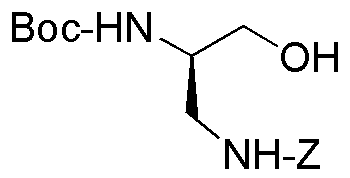(R)-Na-Boc-Nb-Z-2,3-diaminopropan-1-ol is widely utilized in research focused on:
- Pharmaceutical Development: This compound serves as an important intermediate in the synthesis of various pharmaceuticals, particularly in the development of drugs targeting neurological disorders.
- Bioconjugation: It is used in bioconjugation processes to attach biomolecules to surfaces or other molecules, enhancing the specificity and efficacy of drug delivery systems.
- Peptide Synthesis: The compound plays a crucial role in peptide synthesis, where it acts as a protecting group, allowing for the selective modification of amino acids.
- Research in Catalysis: It is utilized in catalysis research, particularly in asymmetric synthesis, where it helps in producing chiral compounds with high enantiomeric purity.
- Diagnostics: The compound is also applied in the development of diagnostic agents, aiding in the detection and monitoring of various diseases through targeted imaging techniques.
General Information
Properties
Safety and Regulations
Applications
(R)-Na-Boc-Nb-Z-2,3-diaminopropan-1-ol is widely utilized in research focused on:
- Pharmaceutical Development: This compound serves as an important intermediate in the synthesis of various pharmaceuticals, particularly in the development of drugs targeting neurological disorders.
- Bioconjugation: It is used in bioconjugation processes to attach biomolecules to surfaces or other molecules, enhancing the specificity and efficacy of drug delivery systems.
- Peptide Synthesis: The compound plays a crucial role in peptide synthesis, where it acts as a protecting group, allowing for the selective modification of amino acids.
- Research in Catalysis: It is utilized in catalysis research, particularly in asymmetric synthesis, where it helps in producing chiral compounds with high enantiomeric purity.
- Diagnostics: The compound is also applied in the development of diagnostic agents, aiding in the detection and monitoring of various diseases through targeted imaging techniques.
Documents
Safety Data Sheets (SDS)
The SDS provides comprehensive safety information on handling, storage, and disposal of the product.
Product Specification (PS)
The PS provides a comprehensive breakdown of the product’s properties, including chemical composition, physical state, purity, and storage requirements. It also details acceptable quality ranges and the product's intended applications.
Certificates of Analysis (COA)
Search for Certificates of Analysis (COA) by entering the products Lot Number. Lot and Batch Numbers can be found on a product’s label following the words ‘Lot’ or ‘Batch’.
*Catalog Number
*Lot Number
Certificates Of Origin (COO)
This COO confirms the country where the product was manufactured, and also details the materials and components used in it and whether it is derived from natural, synthetic, or other specific sources. This certificate may be required for customs, trade, and regulatory compliance.
*Catalog Number
*Lot Number
Safety Data Sheets (SDS)
The SDS provides comprehensive safety information on handling, storage, and disposal of the product.
DownloadProduct Specification (PS)
The PS provides a comprehensive breakdown of the product’s properties, including chemical composition, physical state, purity, and storage requirements. It also details acceptable quality ranges and the product's intended applications.
DownloadCertificates of Analysis (COA)
Search for Certificates of Analysis (COA) by entering the products Lot Number. Lot and Batch Numbers can be found on a product’s label following the words ‘Lot’ or ‘Batch’.
*Catalog Number
*Lot Number
Certificates Of Origin (COO)
This COO confirms the country where the product was manufactured, and also details the materials and components used in it and whether it is derived from natural, synthetic, or other specific sources. This certificate may be required for customs, trade, and regulatory compliance.


